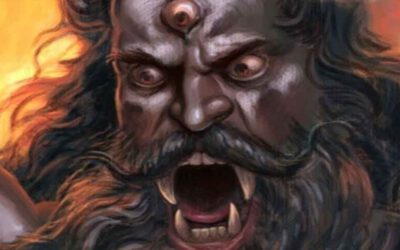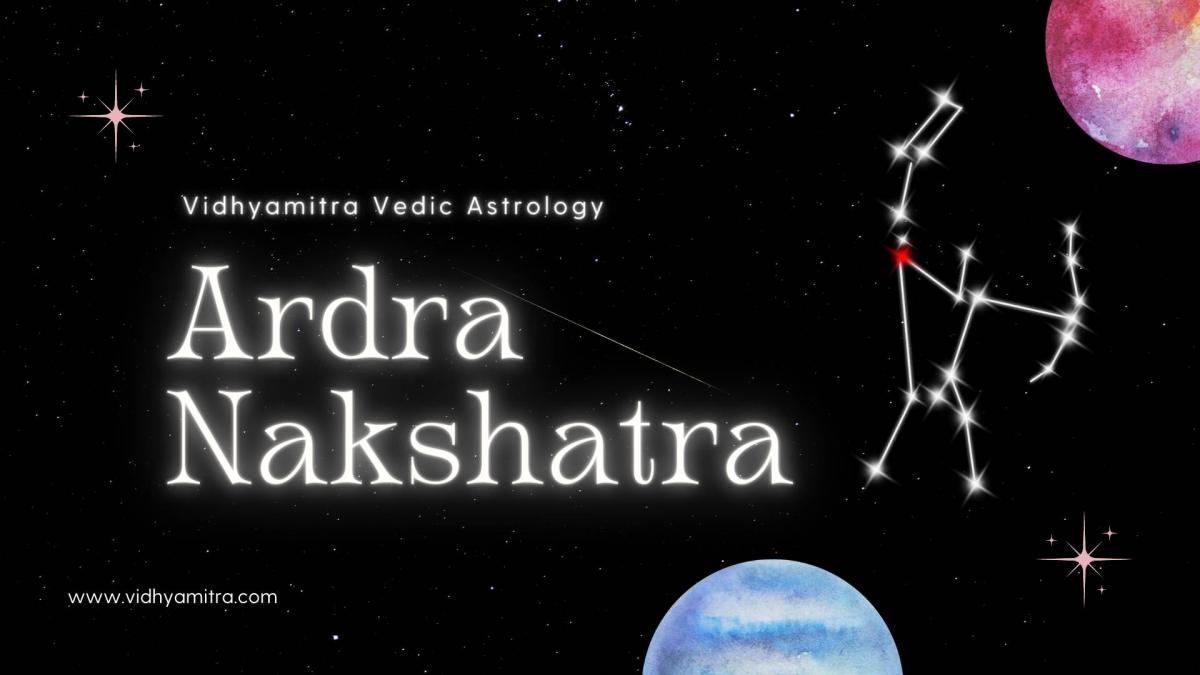#ARDRA #NAKSHATRA

#Rudra is the teacher who teaches us
to contain, and to spiritually empower ourselves
with the Primal rage of existence.
https://www.ancient-tantra.com/63-ardra-nakshatra/
Ardra Nakshatra is the lunar house of the raging god Rudra.
Destruction and Re-creation are both themes of Ardra.
This #Star is connected deeply to the #water element, #Green is the colour of Ardra, we can take this green colour to mean the growth that ensues after the moisture fertilizes the soil of the #soul.
It is the star #Betelgeuse in the shoulder of the hunter, in the constellation of #Orion.
This is the celestial warrior Orion, whose name is most probably derives from the Greek word Arion which means hunter.
Ardra actually means moist. The symbol of this star is a teardrop, a teardrop of emotion and the rains of life.
The lessons of this star is given by considering how the rains bring growth and life, while also considering how the rains can also flood and ravage.
Ardra also contains the word Rudra and is also simply called Rudra Nakshatra.
The rain of Ardra is a furious thunderous storm and not a sprinkling twinkling shower. The water of Rudra is not a sweet refreshing freshwater stream in the height of summer, but rather it is a tempest of crashing screaming waves in the bone splitting coldest and darkest corner of the ocean.
Rudra arrived in the world howling and roaring like cosmic thunder.
Rudra in fact, means the howling screamer. He was born androgynous, purple and wild.
Creativity takes destruction and combustion to ensue, like a cloud that opens its waters for the sake of growth and nourishment. Creation takes death and transition. Death is implicit in every act of creation. Rudra is that death.
Rudra is #Shiva in his #primal aspect. Rudra is the furiously red lord of #Tantra who becomes the cool blue Shiva, after immersing himself in Yogic practices.
Shiva is the mastery of the raging Rudra energy. Shiva contains the root Shva, which implies death, calmness and stillness. Rudra brings the death of rebirth. Rudra is the transitional maneuver twixt the poles of tension and suspension. Rudra takes us from one state to another.
That becoming Shiva, is representative of the transition between storm and calm. Rudra to Shiva is the path of integration of the stormy forces of the heart.
Rudra is the teacher who teaches us to contain, and to spiritually empower ourselves with the Primal rage of existence.
When the storms of the heart are brought forth. Rudra can and does shift back from his Shiva state and unto his raging Rudra state of wild and destructive force.
We will now look at some stories that highlight this transition between Rudra and Shiva.
The stories tell us how the desire of the creator to populate creation gave #birth to Rudra. This will be a simplification a longer more detailed tale, but we will bring out the most poignant points.
At first the creator had a desire to populate the creation. And so some children were birthed. But the children were so calm and detached, that they had any desire to do anything of the sort and refused to populate the creation. Instead, they wanted fly the starry sky in meditation of the great mysteries.
These were the 4 Kumar brothers who are perpetually young little boys, they never reach puberty and fly around the skies naked. They were not interested in the least about the creation, but rather just wanted to be left alone, so that they could meditate of the mysteries of the great beyond.
The creator became furious that these children defied his will. The creators anger built up in his third eye Chakra. A frown knotted his brow and built up to such an extreme, that it erupted as a storm. And so Rudra was born of the rage and frustration of the creators third eye Chakra.
Rudra was born bright purple, it’s significant that Rudra is a mix of opposites. He contains both male and female and the colours red and blue.
Rudra roared and screamed so forcefully that his rage threatened to erode and crumble creation. His rage was so destructive that it had the potential to create.
Rudra then exploded into half. He became Rudra and Rudrani the red. They further exploded into 11 furious forms and continued to populate creation.
Rudrani is the female half of Rudra. Rudrani finds her expression in her various incarnations of the Urga (fearsome) Devi’s (Goddesses). The fearsome goddesses such as Nrritti and Matangi are two such manifestations of Rudrani.
The male Rudra also has his incarnations, Hanuman and the serpent Ajaikapad, for example, are two of the manifestations of Rudra.
The Rudric forms that started to populate the creation were at the same time destroying it.
The creator told Rudra that there is a way to manage this destruction if he would do Yogic practices and Rudra was very interested in the proposal.. And so the creator taught Rudra the Yogic art and science of yore.
Rudra went far into the wilderness and mountains and there spent aeons mastering Tantric Yogic wisdom.
Rudra developed the Yogic wisdom to levels far beyond what even the creator had taught him or ever even conceived of. Rudra broke on through to the other side, far beyond the known borders of creation. That is his secret magic trick that he brings to us. Rudra destroys the known order, in order to create something yet unknown.
Rudra is the ultimate Yogi who works with the forces of destruction.
When Rudra came down from the mountain, he was Shiva.
He had worked with the malefic destructive force and appeared as the ultimate benefic mellow Yogi that is Shiva. Now the creation had another face and destructive force could be balanced.
Consider some of the key points of this story in the list below and meditate upon the symbol of Rudra going up the mountain and coming down as Shiva. What connotation could the upward and downward maneuver imply.
The calm firstborn children 4 Kumaras who had no desire for to populate creation.
The androgynous Rudra splitting into the male Rudra and the female Rudrani.
Rudra, going up the mountain to work in solitude his anger.
Coming down the mountain as the calm Shiva.
Rudra is an out cast, he doesn’t see within the known bounds, this is the power that his star brings to us. The time-honoured conservative, along with his precious structures, is torn to bloody shreds by the bare hands that gleam in the starlight of Ardra Nakshatra. These be the Hands of Rudra.
The story of Rudra and Sati is a central Tantric tale that tells that the princess Sati was in love with the wild Rudra who lived in the wilderness. Sati was determined to unite with Rudra. This destiny of hers caused great storms with her father Daksha who was a highly honoured master of ritual and magical creation of forms. He was a royal king of high prestige, possess of profound pride stubbornness and arrogance.
Daksha was the ultimate patriarch who was concerned with royal appearance, dominance and prestige. Rudra on the other hand couldn’t care less for outer appearances, he was too far-sighted beyond the surface of the appearances of things. Rudra saw into the depth into a place where there was no form to cover the naked essence. Rudra is verily that deep essence. He has no need for anything because he has everything in his vision that sees the indivisible pure essence behind all forms.
Sati is the link between wilderness and propriety. She is the one who stands between the worlds of wilderness and propriety as we will see.
Sati had a hard time getting Shiva’s interest, as he was often deep in trances of visiting the realms of pure energy behind the surface of appearances. Locked in Samadhi, (meditational absorption) Shiva would sit on the earth but hardly be interacting with any of its endless infinity of forms. Sati did prevail in her wish to be with Shiva, and she joined him in the ways of the wilderness. They both stood far outside and beyond civilisation, Rudra initiated Sati ever deeper into the ways of nature. Rudra didn’t dress or wash or even comb their hair. His friends were the earth bond spirits and ghouls. Shiva indulged in ecstatic trance and kept warm by the fires of the funeral pyres where he would befriend the lost and wandering ghosts.
Sati was of high class aristocratic stock, but she found more jewels wealth in her time with Rudra. Sitting in Yogic wonder beneath the dark star-sprinkled night, Sati found real royalty.
But Sati wanted to do things properly and formally, and so she told her father Daksha that she would get married to Rudra.
Her opulent honourable father hated Rudra to the core. In Rudra, he saw his very opposite. To him, Rudra was a filthy outcast who didn’t know the appropriate way to behave in proper society. Sati’s father Daksha, time and again brutally opposed the marriage. This is an important point in the story that points to Sati’s role as the bridge between two worlds of the wilderness of Rudra and the aristocratic propriety of her father Daksha.
Sati prevailed and she brought Rudra Home. Of course, within moments, Rudra caused outrage and scandal.
In the royal court, Rudra was quite a sight to behold, naked with matted hair, accompanied by hoards of ghoul and ghost.
When Daksha entered his own royal court, everyone stood to acknowledge him as was the custom for such an esteemed dignitary as he. Everyone that is, except Rudra.
Insults and outrage ensued and Rudra stayed self-contained and walked away.
At this point Rudra had already been doing the sacred Yogic practices for aeons.
Time passed magically in the wilderness for the two lovers, when one day Sati wanted to go and see her family, she had developed a profound disgust and hatred for her father. She had been the youngest favorite daughter but bitterness had ensued since her willfulness to go and live with Rudra the wild one.
Rudra tried to stop her from going as he knew what would happen, but of course the forcefully willed Sati went ahead anyway.
In the royal palace, argument ensued between Sati and her father.
Rage shook Sati as insults were hurled between her and her father. Sati shouted out at her father that all would witness how his arrogance, hate and pride will disgrace him, and that he shall forever-after be known as the epitome of patriarchal ignorance that resulted in his daughters death.
And so Sati sat down and prepared to say the Mantra which would cause her to combust into flames. Some variants of the story said she jumped into the sacred sacrificial Yanja fire. A Yajna is a ritual fire to which sacrificial offerings are given.
Sati burned to death right in front of everyone in the palace.
The shame and guilt of his youngest daughters death was on Daksha. But he was soon to meet a foe far worse than any of this.
The ghosts of Rudra informed Rudra what had happened, and his wrathful side was evoked. Rudra tore at his Jutta (locks of matted hair) and threw them on the ground in rage, from one of the Jatta appeared the giant Bhadravira, the potent force of Rudras rage, Rudra as Bhadravira charged the galaxies like a raging storm that went tearing its way through creation.
Meanwhile, in the royal palace, insults were hurled between ghost and saint. The storm clouds rumbled through creation and the royal assembly felt the terror in the pit of their bowels. When Bhadravira arrived in his raging form of Bhadravira, the full force of his primal screaming rage set lose, eyes were squeezed out of heads, wise old beards were yanked clean off the face, most probably with half the flesh of the face.
Pushan the milk drinking god had his teeth smashed out.
(Note that Pushan is the god of Revati Nakshatra, you may review the text here.)
http://www.healinginthewillows.com/revati-nakshatra
Before going further with the story, let us consider the ruling planet of Ardra Nakshatra, which is Rahu. Rahu is the headless North lunar node as pictured above. He is considered as one of the Navagrah, (9 planets of the Yogins) Rahu moves out and forward and is ever consuming hungrily what ever he can. He represents the future and also the results of ones past actions. It is interesting to look at how the head symbolism plays out very strongly in Ardra Nakshatra. This will be our next line of study. But first a little more on Rahu. Though Rahu is often described as being male, he is also said to carry the energy of the ultra destructive feminine.
The destructive Goddess Nirrti carries a Rahu energy, she is the Goddess of Mula Nakshatra, she is a Rudrani.
You may review the text on that which was sent in the newsletter on the 24th of June 2021. (Please request it if you have not got it and wish to read it.)
Nirrti’s Nakshatra is ruled by Ketu which is the South lunar node, she is a destructive goddess who moves between the past and the future, she is Rahu personified yet works with the root and uprooting. Her Nakshatra Mula literally translates at the Root star.
Ketu represents the roots of the past, all things ancestral and of heritage.
#Rahu are the ultimate Asuras, they were once one being that became divided.
It’s interesting also that Rahu is the planet that causes the eclipse of the sun by literally gobbling it down. Interesting because Daksha was the great solar patriarch who worked with fire in his rituals. He was a master at manipulating fire for magical purposes.
The name Daksha can also be taken to mean the great skillful manipulator.
We could say that the Rudra force of Ardra Nakshatra backed by Rahu, came and gave Daksha the result of his past actions of disregarding and insulting his daughters feelings and harboring hatred for Rudra, not to mention the rebound echo of beheading so many animals for the magical rituals in which he was engaged.
Daksha lost his head quite literally in the Story.
The Daksha aspect of Rahu is represented in the hunger and want of Rahu. Daksha is ever on the quest for more power and prestige. He is like the Rahu head without body, ever consuming and yet is never satisfied. The Rudra aspect of Rahu is the eclipsing of the fire and shading things into obliteration. Daksha along with his dear Yajna fire was obliterated. Sati as Rudrani combusted to a charred body without its previous glow.
This is what Rahu does, he is a planet that works on different octaves of eclipsing.
The story shows these different octaves of Rahu force in the form of Daksha, Rudra and Sati.
And so finally, for the grand finale, the head of Daksha was wretched screaming from his body and the headless patriarch was born. Some accounts tell that Rudra wielded the Moon sword known as Chandrahas, and decapitated the head from the body of Daksha.
Daksha was a master of ritual and was given to the sacrifice of animals for magical gain. There is such a branch of magic still in existence where the etheric force of sacrificed animals is gathered and put towards the fulfillment of the desired ends. Though it is a powerful form of magic, it carries rather costly Karmic consequences.
There are some parts of India where even orthodox priests still adhere to this practice to fulfill requests. Religion is a big business in India, one can pay for such rituals. Obviously there are other rituals that do not involve animal sacrifice. There are many types of practitioners that come under the title of a Tantric . Some are doing rituals for others, those in the line of teachers of the techniques are more on the side of teaching others how to do their own rituals. Some Tantrics believe they find loopholes to get out of the Karmic repercussions of actions like animal sacrifice.
Some of the branches of Tantra deal with healing and study of the soul, but not all branches do. Some of the modern Western branches of Tantra deal with drinking strong chocolate and masturbating their clients on a massage table while New-Age music plays peacefully in the background. The spectrum of what is considered Tantra is indeed broad.
Dasksha was of the side that indulged in ritual for material gain. He was a powerful manifester. His name in fact means he who is highly adept. Daksha is a Prajapati, which means he is one of the progenitors of creation. He it was who gave birth to the 27 sisters who are the Nakshatra’s. He was arrogant, haughty and proud. To him, beauty form and manners were paramount.
Daksha is the energy that cares for what people think.
Daksha is the energy that cares for facade and appearance.
Because of this love of external form and obsession with order and cleanliness, Daksha dispised the wild natural Rudra who lived outside the principles of convention.
It was the Daksha Yajna story that really highlights the meeting of the two worlds of raw natural impulse and exterior edifices of propriety.
The Yajna had invited everyone apart from Sati and Rudra. But Sati had gone anyway and as we have seen, met her end.
The story is very detailed and has many subtle meanings woven into its narrative, right down to the directions where the many events happen are poignant and give teaching of the qualities and powers of the directions.
We are here dealing with the main points.
One such detail of note, is that the Bhadravira form of Rudra could not kill Daksha so easily.
Daksha was protected by the rituals he had been conducting for aeons in his own place of power.
Rudra’s form of Bhadravira saw that there was one place where Daksha was not protected, and so he dragged the pitifully screaming Daksha to the place where he had been sacrificing animals. He placed Daksha on the sacrificial altar and…
Off with his head!
OFF WITH HIS HEAD!
Oh! but there are a few other heads that come off in the story of Rudra, there are several stories and variants of heads being withdrawn from their bodies when we look at Rudra. Note again the Rahu connection. Rahu also once had a body before his head sliced from it . He was once an Asura who drank the elixir of immortality. Vishnu steppers in and cut the head with his spinning Chakra weapon. The head and body were hurled into the celestial expanse, where the head became Rahu at the north of the Moon, and the Body became Ketu at the south of the Moon, forever they became immortalised at the cosmic shadows upon Moon and sun.
Let’s look at another head of interest that was dispensed from its body. The sacrifices of Daksha are known as Yajna. And Yajna is also the name given to the one who does the sacrificing himself.
#Yajna saw the storming Rudra charge the palace in his Bhadravira form. Yajna trembled in fear and knew he had to escape. Transforming into a Deer, he leapt from the palace, but with the force of a steaming thunderbolt, the giant Bhadravira grabbed the head, yanking it clean from the body, he threw it into the starry firmament. That head became the Nakshatra of the Deer head. Known as Mrgasirsa Nakshatra. This Deer star is beside Ardra Nakshatra.
Mrgasirsa literally means Deer headed lunar house.
To review the writing of Mrgasirsa, you may refer to the text on the website with this link.
The events of this particular part of the tale occur in the Nakshatra of Ardra. This story gives us an insight into what the energy of Ardra Nakshatra represents.
A TIME TO #CRY
On with the story!
After a sufficient amount of bodies were made headless. Rudra picked up the dead burned body of his beloved Sati and proceeded to freak out in primal rage and trample his way all over creation.
His tears do water the land. Rudraksh means the tears of Rudra. Rudraksh is a sacred seed that is carries a potent force, Yogins recognise many types of Rudraksh, the seeds have segments which are called Mukhi (face) each different number of faces on a Rudraksh gives it a particular quality and so different types of Rudraksh have different effects. This is a wisdom kept by Yogins. It’s a very detailed subject that assigns different types of Rudraksh seeds to different planetary forces and deities. Sometimes medicines are prepared from the beads in the Siddha secret medicine of the Yogins. There are many stories both written and unwritten that tell of how the sacred Rudraksha came to earth and it’s significance for Yogins. Let us consider one such story here.
The Tantric wears a bead necklace of 108 beads to represent the 108 tears that Rudra cried as he howeled his way through creation in utter distress, carrying the burned rotting body of his only love Sati.
Each time a part of the dead body of Sati fell off, Rudra wept a tear as she faded further from him.
Where his tears fell with the body part of Sati, that place became one of the 108 Shakti Peeths. The Shakti Peeths are places of magnetic power of the temples of the Goddess in her different aspects. Each Shakti Peeth carries a different power. For example, where the Yoni and the Womb of Sati fell, that place became the Shakti Peeth of Kamakhya Devi. Kamakhya Devi is the Goddess of menstruation and desire.
Kamakhya’s #Shakti Peeth is located in Assam.
In some of the lines of Tantra, the wandering Tantrics wander the land in the footsteps of Shiva, and give honour to the Shakti Peeths.
For example, on the Moon of #Bharani Nakshatra. Some Tantrics travel to the Kamakhya temple in Assam for connection to the mysteries of the Goddess. Shakti Peeths are astrologically aligned to the Nakshatra’s and transport their teachings.
Bharani Nakshatra is the lunar house of the celestial Yoni.
You may review the text on Bharani here.
http://www.healinginthewillows.com/bharani-nakshatra
Rudra is the storm god of water, we have seen how his Nakshatra is symbolised by a teardrop. The word Ardra means moist.
But Rudra also symbolises fire. The story of Rudra shows how he came in a storm to the royal Yajna of Daksha and took the still burning body of Sati away with him. There are some accounts that say that his houses and ghoul companions had pissed of the sacrificial Yajna fire and created noxious gasses that caused abject suffering for those who breathed them in.
This contention between Fire and water is very poignant to Rudra.
When a Nakshatra spans two signs between water and fire, then that junction becomes what is an own as a Gandanta point. It is a place of steam. Steam is rain, this is the steaming moisture of Rudra. A Gandanta point carries Karmic lessons and is a place of learning though the art and style of Rudra, often with tears and fire.
The whole movement of a Rudra storming into the fire ceremony of Dasha’s Yajna, is a portrayal of the Gandanta point. Rudra verily is the Gandanta point. He came in a storm and left with fire in the form of Sati’s still burning body.
It is known that Rudra lives in the cremation grounds where he warms from the funeral fires and befriends wandering ghosts. Rudra wears the ash of the funeral pyre, this is a custom that some Yogins still follow. Ash is the place where fire and water meet.
Let us look further into the implications of the fire and water that Rudra represents.
Rudra has two other Nakshatra’s that further point to the principle of him ruling the Gandanta points.
The 2 Bhadrapada Nakshatra’s of Purva (origin) and Ashadha (maturity) are the two Nakshatra’s of Rudra that are ruled by him in his form as the incarnations of the celestial serpents of fire and water.
The first serpent form of Rudra is called Ajaikapad who the fire serpent and ruling deity of Purva Bhadrapada. The second serpent form of Rudra is called Ahirbudhyana who is the water serpent and ruling deity of Uttara Bhadrapada. They are two aspects of Rudra, and are both the fiery and watery incarnations of Rudra.
In the human body the Gandanta points are called the Granthi’s. These are the psycho/physical knots where Karma is tied up. Rudra is the one who releases the Knot, He offers 11 incarnations, which are the teachings of releasing Gandanta. The Ritual work with Rudra of Saturday’s dark Moon will further develop towards the home meditation of working with the 11 faces of the Primal Rudra.
The primal Rudra is the primal rage.




